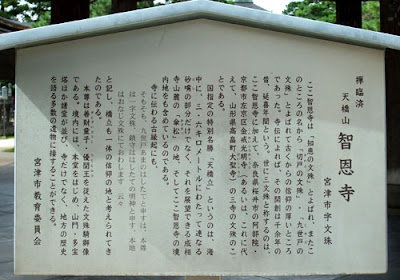After the View Land, we went to
Chionji Temple which was sacred to Manjusri, or, a bodhisattva associated with transcendent wisdom. The statue is not usually shown to the public, but people have believed in its benevolence very much. So, this temple is one of main spots around
Amanohashidate.
 |
| The Entrance to Chionji Temple. |
We say
Monju for Manjusri in Japanese. Many places were named after
Monju or something related with wisdom. For example, we had come down from View Land on Mt.
Monju and the word "chion" of this temple's name means "the benefit of wisdom".
.jpg) |
Zen, Rinzai Denomination
Tenkyo-zan Chionji Temple*
at Aza Monju, Miyazu City
Chionji have been believed very much and wel-known as "Manjusri, the wisdom". Or, people used to call it "Manjusri of Kireto" or "Manjusri of Kuseto" after acient place names around here. The tradition says that Chionji was built about one thousand years ago, during the Engi period (AD.901-923). What is called the Three Manjusri of Japan are here in Chionji, in Abein Temple, Sakurai City, Nara Pref. and in Konkai Komyoji Temple, Sakyo-ku Ward, Kyoto City (or, in Daijoji Temple, Takahata Town, Yamagata Pref.)
Amanohashidate is a government-designated special place of scenic beauty. It does not include only the sand spit 3.6 kilometers long across the bay, but also "Kasamatsu Area" from where people can view the sand spit and also here, the precincts of Chionji Temple where you stand.
Its old archive says that;
originaly, in Kuseto in Amanohashidate, there have been both of the principal statue of Manjusri and the Shinto shrine of its guardian, Hahidate Myojin. They have deep relations on the same Manjusri.
Therefore, the sand spit and Chionji have been regarded as the same one for religious faith.
The principal statue is Manjusri mounting a lion accompanied by Sudhana (Child of wealth) and Udayana (a prince in ancient India). There are Mahavira hall, gate, pagoda and so on within its precincts. From them we can understand the history around here, too.
Miyazu Municipal Board of Education |
 |
Pagoda, 1501
Designated Important Cultural Properties of Japan
An architecture in the Medieval Period is very rare in Miyazu City. |
 |
Monjudo, the Mahavira Hall
Although it have been rebuilt many times,
it is said that the four innermost columns are left from the mythological age.
The statue of Manjusri is in this hall.
His accompanied animal is a lion.
There are a lot of place names related Manjusri, wisdom and a lion
around Amanohashidate.
That proves ancient religious belief in Manjusri here. |
 |
Tetsu Yubune, an iron vessel for hand washing, 1290
Designated Important Cultural Properties of Japan
This was originally used as a bath tub for Buddhist monks.
Today, we usually wash our hands to purify ourselves
before going to worship at Monjudo |
 |
An incense holder in front of Monjudo
People offer sticks of incense from the both sides before entering to the hall.
Instead of getting the stick, we usually make
a little monetary offering into the box on the center. |
 |
The smoke from incense maybe makes us wiser.
We usually gather the smoke to our heads. |
 |
The inner side of Monjudo from a garden.
People are expected to stop taking photos
of the most sacred space. |
 |
We tried the fortune
whose shape was a fan very singularly
My fortune oracle was "Blessing"
It was not good, and not bad. |
 |
| This house was in Chionji, too |
 |
| In front of it, a cat was sleeping like a doll |
After
Chionji Temple, we walk around there.
 |
Chie no wa, a big ring of wisdom.
It is said that if you can pass through it,
you should be given the wisdom by Manjusri.
A kid or a baby could do it. |
 |
For lunch, I ate Kaisen don,
rice covered with fresh sea foods in a bowl.
We were near the sea indeed! |
Access
Chionji Temple: several minutes walk from
Amanohashidate St. and the Lift and Monorail St.
Chie no wa ring: a few minutes walk from
Chionji
Fee
Chionji Temple: free (but monetary offering around a few hundred yen are expected to worship.)
Fortune of fan shape: 300 yen (maybe)
Chie no wa ring: of course free
More detailed for
Chionji Temple: (Japanese)
http://www.monjudo-chionji.jp/
* The formal name of temple in Japan is composed of a mountain name and a temple name. The formal name of
Chionji is "
Tenkyo-zan Chionji". In this case, "Tenkyo-zan" is its mountain name and "
Chionji" is its temple name. "
Ji" means a temple, "
zan" means a mountain and "
Tenkyo" is another way of saying "
Amanohashi(date)".
Thank you for reading! Sorry for my poor English. If you have any questions, take it easy to ask me! Also, I would like you to correct my errors, if you could.









.jpg)



No comments:
Post a Comment